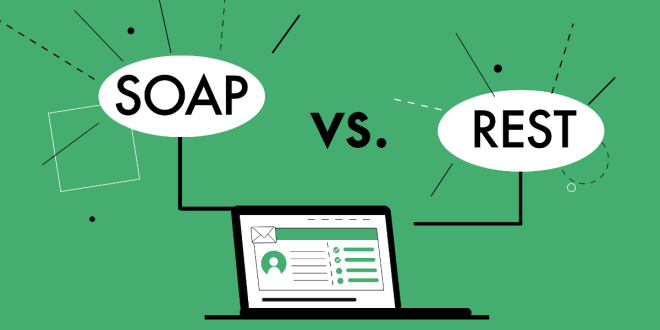When building web applications, the ability to exchange data between systems is of paramount importance. This is where web services come into play. Web services enable communication between different platforms, allowing seamless data transmission. Over the years, two primary architectures have emerged as the most prevalent solutions – SOAP Web Services and RESTful APIs. Understanding their differences, advantages, and use cases is vital for any tech enthusiast or developer. So, let’s dive into the world of SOAP Web Services and RESTful APIs.
Underlying Principles and Communication Protocols
SOAP Web Services
SOAP, based on XML, has been around for a longer time and follows a strict set of protocols for communication. It relies on the XML schema for defining the structure of messages and utilizes HTTP, SMTP, TCP, and more for transport. SOAP is known for its rigidness, which ensures a high level of security and reliability in data exchange.
RESTful APIs
On the other hand, RESTful APIs are built on the principles of Representational State Transfer (REST). They leverage HTTP methods like GET, POST, PUT, DELETE, etc., for communication, making it more straightforward and lightweight compared to SOAP. RESTful APIs use standard data formats such as JSON, XML, or HTML for data representation.
Key Points:
- SOAP Web Services are based on XML and have strict communication protocols.
- RESTful APIs follow REST principles and use standard HTTP methods.
Flexibility and Ease of Implementation
SOAP Web Services
SOAP Web Services excel in handling complex operations, thanks to their built-in security and ACID compliance (Atomicity, Consistency, Isolation, Durability). However, this comes at the cost of increased complexity and verbosity in the XML format. Implementing SOAP Web Services might be more time-consuming and require additional tools.
RESTful APIs
RESTful APIs, on the other hand, are lightweight and easier to implement. They focus on simplicity and use standard HTTP methods for data exchange. Their flexibility and scalability make them suitable for most web applications. However, RESTful APIs might lack certain security features present in SOAP Web Services.
Key Points:
- SOAP Web Services offer robust security and support for complex operations.
- RESTful APIs are more straightforward to implement and highly scalable.
3. Performance and Efficiency
SOAP Web Services
Due to the XML format and strict protocols, SOAP Web Services can be relatively slower compared to RESTful APIs. The parsing and validation of XML data add overhead to the process. However, advancements in technology have improved performance, making SOAP a viable option for enterprise-level applications.
RESTful APIs
RESTful APIs, being lightweight, are generally faster and more efficient. They transmit data in formats like JSON, which are easier to process. The reduced overhead and simplicity contribute to better performance, especially in mobile and web applications.
Key Points:
- SOAP Web Services might have slower performance due to XML processing.
- RESTful APIs are more efficient and faster, especially in mobile and web applications.
Interoperability and Support
SOAP Web Services
SOAP’s strict standards ensure a high level of interoperability between different systems. This is particularly advantageous when dealing with legacy systems and heterogeneous environments. Additionally, SOAP Web Services have excellent support for WS-Security, making them an ideal choice for enterprise scenarios.
RESTful APIs
RESTful APIs also offer good interoperability, especially in modern web and cloud-based environments. They are widely supported across various programming languages and platforms. However, issues might arise when integrating with legacy systems due to differences in architectural principles.
Key Points:
- SOAP Web Services excel in interoperability, especially with legacy systems.
- RESTful APIs offer good support across modern platforms and programming languages.
Error Handling and Statelessness
SOAP Web Services
SOAP is designed with strong error handling capabilities, making it reliable for critical applications. It uses standardized fault elements to convey error messages and ensure proper error resolution. Moreover, SOAP Web Services support stateful communication, which can be beneficial for certain scenarios.
RESTful APIs
RESTful APIs, in contrast, follow a stateless communication model. Each request is independent, and the server does not retain any session information. Error handling in RESTful APIs relies on HTTP status codes, which might be less detailed than SOAP’s error messages.
Key Points:
- SOAP Web Services have robust error handling capabilities.
- RESTful APIs follow a stateless communication model.
Final Words
In conclusion, the choice between SOAP Web Services and RESTful APIs depends on your specific project requirements. SOAP Web Services provide high security, reliability, and are suitable for complex operations in enterprise settings. On the other hand, RESTful APIs are lightweight, easy to implement, and highly scalable, making them a preferred choice for modern web and mobile applications.
While SOAP Web Services might be preferred for traditional enterprise environments, RESTful APIs shine in today’s fast-paced, interconnected digital landscape. Consider your project’s needs, the existing infrastructure, and the performance expectations to make an informed decision.
Commonly Asked Questions
Q1. What are the main differences between SOAP Web Services and RESTful APIs?
SOAP Web Services use XML and follow strict communication protocols, providing robust security and support for complex operations. RESTful APIs are based on REST principles, use standard HTTP methods, and are more lightweight and easier to implement.
Q2. Which is better for modern web applications, SOAP Web Services, or RESTful APIs?
For modern web applications, RESTful APIs are often preferred due to their lightweight nature, scalability, and efficient performance. They are better suited for mobile and web-based environments.
Q3. Are SOAP Web Services suitable for integration with legacy systems?
Yes, SOAP Web Services excel in interoperability, making them an ideal choice for integrating with legacy systems and heterogeneous environments.
Q4. What advantages do RESTful APIs offer over SOAP Web Services?
RESTful APIs are easier to implement, faster, and more efficient compared to SOAP Web Services. They also have wider support across different programming languages and platforms.
Q5. Can I use both SOAP Web Services and RESTful APIs in a single application?
Yes, it is possible to use both SOAP Web Services and RESTful APIs in a hybrid application, depending on the specific functionalities and needs of different parts of the application.
 webfily
webfily



